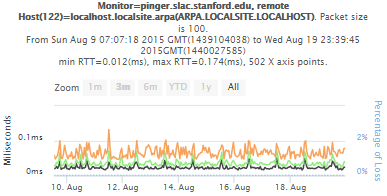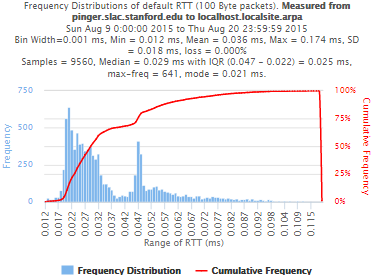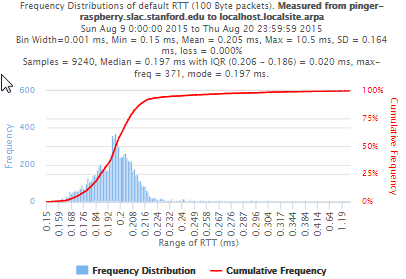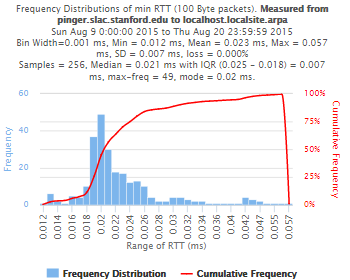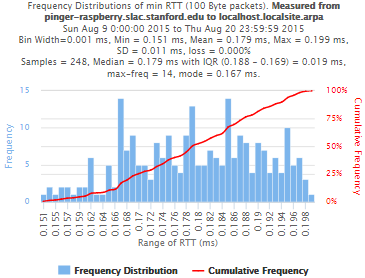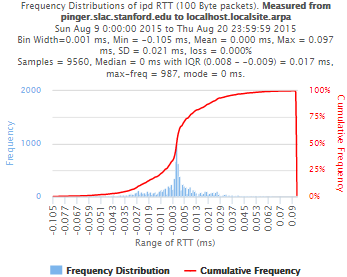...
Localhost comparisons
To try and determine more closely the impact of the host on the measuremensts we measured to the measurements, we eliminated the effect of the network by making measurements to the host's localhost NIC port from August 9th to August 19th. Looking at the time series analyzed data it is apparent that:
- the pinger hosts has considerably shorter RTTs
- the pinger host has fewer large RTT outliers
...
- the pinger host's Median RTT is 7 times smaller (0.03ms vs 0.2 ms) than that of the raspberry-pi
- the pinger host's maximum outlier (0.174ms) his is ~ factor 60 smaller than the raspberry-pi.
- the pinger host exhibits a pronounced bimodaility not seen for the raspberry-pi.
- The the IQRs are very similar (0.025 vs 0.020ms)
Looking at the IPD distributions it is apparent that:
- the pinger distribution is much sharper (max frequency 987 vs 408 for raspberry-pi)
- there is a slight hint of multi-modaility in the pinger distribution less visible in the raspberry-pi distribution
- the minimum and maximum outliers are about a factor 100 lower for pinger than the raspberry-pi (~ +-0.1 vs ~10ms)
- the IQR's are similar (0.017ms), whereas the standard deviations differ by almost a factor of 10 (0.021ms vs. 0.227ms. This further illustrates the impact of smaller outliers seen by pinger.
Though there are large relative differences in the distributions the absolute differences of the aggregated statistics (medians, IQRs) are sub millisecond and so should not noticeably affect PingER wide area network results.
Though we have not analyzed the exact reason for the relative differences, we make the following observations:
- The factor of 7 difference in the median RTTs is probably at least partially related to the factor of 5 difference in the clock speeds (3Ghz vs 600MHz).
- Looking at the minimum RTTs for each set of pings it is seen that pinger has a larger ratio of median RTT / IQR compared to the raspberry-pi (0.33 vs 0.096).
- This may be related to the fact that the pinger host is less dedicated to acting as a PinGER MA since in addition it runs lost of cronjobs to gather, archive and analyze the data. This may also account for some of the more pronounced multi-modality of the pinger host's RTT distributions.
- Currently we do not have a rationale for the reduced outliers on pinger vs the raspberry-pi.
| pinger. | pinger.slac.stanford.edu | pinger-raspberry.slac.stanford.edu | pinger-raspberry.slac.stanford.edu | ||
|---|---|---|---|---|---|
| Time series | |||||
| RTT frequency | |||||
| Minimum RTTs for each set of 10 pings | |||||
| IPD frequency |
Kolmogorov-Smirnov Test
...
